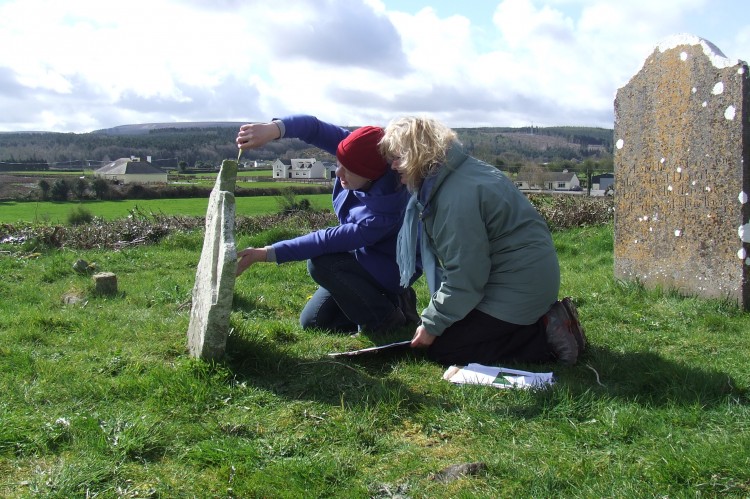Location
 Our visiting gravestone memorial iconography expert, Gerry Mullins, got very excited in Kilmanman graveyard, during the second of the Historic Graves, graveyard recording workshops in Co. Laois on Saturday the 2nd of April. Gerry was there to assist on the day and quickly became the star of the show because of his knowledge of and enthusiasm for the gravestone memorials.
Our visiting gravestone memorial iconography expert, Gerry Mullins, got very excited in Kilmanman graveyard, during the second of the Historic Graves, graveyard recording workshops in Co. Laois on Saturday the 2nd of April. Gerry was there to assist on the day and quickly became the star of the show because of his knowledge of and enthusiasm for the gravestone memorials.
The day followed the format set during the first workshop, with the twenty participants alternating between three activities; photography and GPS, surveying and gravestone memorial recording. The fieldwork was undertaken in the morning and was followed by talks and live uploading demonstrations back in Clonaslee community centre in the afternoon.
 Gerry was on-hand in the morning to do some gravestone rubbings using the sponge and carbon paper technique. During the course of his 'moochings' around the graveyard he found one headstone in particular which piqued his interest. It very unusually combined elements of pre and post famine iconography on the one stone. The principal IHS motif was flanked by two small winged cherubs which are generally considered to date to no later than the 1780s in Ireland. The two motifs either side of the principal motif were ciborium’s (a chalice with a lid) which largely date to the post famine period. Gerry was also able to discern a floral motif around the edge of the memorial which due to his knowledge of the iconography led him to believe that the headstone commemorated someone of the protestant faith.
Gerry was on-hand in the morning to do some gravestone rubbings using the sponge and carbon paper technique. During the course of his 'moochings' around the graveyard he found one headstone in particular which piqued his interest. It very unusually combined elements of pre and post famine iconography on the one stone. The principal IHS motif was flanked by two small winged cherubs which are generally considered to date to no later than the 1780s in Ireland. The two motifs either side of the principal motif were ciborium’s (a chalice with a lid) which largely date to the post famine period. Gerry was also able to discern a floral motif around the edge of the memorial which due to his knowledge of the iconography led him to believe that the headstone commemorated someone of the protestant faith.
 The ruined church and graveyard at Kilmanman are located on the site of a possibly 7th century early christian monastery founded by St Manman. The site of a holy well can be seen in the field to the south of the graveyard and the Ordnance Survey first edition map records it as St Manman’s Well. Information about St Manman and his monastery is very scarce and his name, at least in the form in which it is known today, does not appear on any of the ancient Irish calendars, however local tradition establishes his Pattern day as the 5th August. According to an Historical Study of the Clonaslee Area undertaken by Clonaslee transition year students in 2003, a nunnery is believed to have been situated nearby and the burial ground was reported to have been dug up in the early nineteenth century by labourer’s of General Dunne, one of the leading landowners in the district.
The ruined church and graveyard at Kilmanman are located on the site of a possibly 7th century early christian monastery founded by St Manman. The site of a holy well can be seen in the field to the south of the graveyard and the Ordnance Survey first edition map records it as St Manman’s Well. Information about St Manman and his monastery is very scarce and his name, at least in the form in which it is known today, does not appear on any of the ancient Irish calendars, however local tradition establishes his Pattern day as the 5th August. According to an Historical Study of the Clonaslee Area undertaken by Clonaslee transition year students in 2003, a nunnery is believed to have been situated nearby and the burial ground was reported to have been dug up in the early nineteenth century by labourer’s of General Dunne, one of the leading landowners in the district.
The workshop seemed to go well and hopefully everybody left enthused and ready to start recording their own local graveyard memorials. Gerry hopes to publish his thoughts on Irish gravestone iconography shortly which will surely be a must read for anyone interested in the subject. We will keep you posted on his progress. The day would not have been possible without the help and support of Orla O’Meara from Laois Leader Partnership and Catherine Casey the Laois Heritage Officer.



